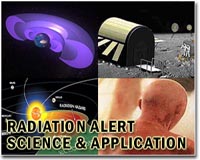 |
Sheffield UK (SPX) May 27, 2011 Iodine radioisotopes are produced by fission of uranium fuel in a nuclear reactor. Radioactive iodine is of concern because it is highly mobile in the environment and selective uptake by the thyroid gland can pose a significant cancer risk following long term exposure. Furthermore, iodine-129, which is a type of radioactive iodine, has an extremely long half life of 15.7 million years, so is one of the most significant long term hazards faced by the population due to its emission during the geological disposal of nuclear waste. Professor Neil Hyatt, from the University's Department of Materials Science and Engineering, has now found a way of locking up iodine radioisotopes in a durable, solid material suitable for ultimate disposal, like lead iodovanadinite(Pb5(VO4)3I). The research, which was published in the Journal of Nuclear Materials, demonstrates how his simple, inexpensive and rapid method can be done at atmospheric pressure. Professor Hyatt and his team created a solid material for immobilisation of iodine with the formula Pb5(VO4)3I, by heating a mixture of lead iodide, lead oxide and vanadium oxide. Previously, this has only been achieved using high pressure and a sealed container, because iodine is volatilised at high temperature. However, using the knowledge that vanadium is a good absorber of microwaves at 2.45 GHz - the frequency used in domestic microwave ovens - the team were able to heat the mixture of chemicals in a microwave oven to produce Pb5(VO4)3I in about three minutes. The key to the method's success is that Pb5(VO4)3I is a poor absorber of 2.45 GHz microwaves, so once this is formed, the sample cannot absorb microwaves, so the temperature does not get high enough for the iodine to volatilise. Iodine-131 was the harmful gas emitted from the Fukushima power plant in Japan following the earthquake and tsunami last month, and was a significant contributor to the health effects from open-air atomic bomb testing in the 1950s, and was also emitted during the Chernobyl disaster. It is hoped the new research will reduce the public health impact associated with the release of radioactive iodine to the environment by providing a simple and inexpensive method of immobilisation in a solid material, which could be rapidly deployed in an accident scenario. Professor Neil Hyatt, said: "In spent nuclear fuel, the iodine is not immobilised, so once the containment is breached it simply gets dispersed. At present, iodine-129 released by nuclear fuel reprocessing is discharged direct to the Irish Sea off the coast of Sellafield. Substantial quantities of this radioisotope were also released into the sea off the coast of Japan in the Fukushima incident. Our new method offers a way of safely and rapidly containing this radionuclide, reducing the potential long term impact on human health from discharge to the environment."
Share This Article With Planet Earth
Related Links - Space Technology News - Applications and Research
 Radiation fears surround France's old uranium mines
Radiation fears surround France's old uranium minesRosglas, France (AFP) May 26, 2011 It looks like any other another leafy woodland path in Brittany, but campaigners say ramblers on this particular trail may face levels of radiation at least 10 times higher than normal. The path runs alongside a disused uranium mine in the hamlet of Rosglas, one of over 200 suspect sites dotted across France, this one marked with just a makeshift sign drawn up by local anti-nuclear campaigne ... read more |
|
| The content herein, unless otherwise known to be public domain, are Copyright 1995-2010 - SpaceDaily. AFP and UPI Wire Stories are copyright Agence France-Presse and United Press International. ESA Portal Reports are copyright European Space Agency. All NASA sourced material is public domain. Additional copyrights may apply in whole or part to other bona fide parties. Advertising does not imply endorsement,agreement or approval of any opinions, statements or information provided by SpaceDaily on any Web page published or hosted by SpaceDaily. Privacy Statement |